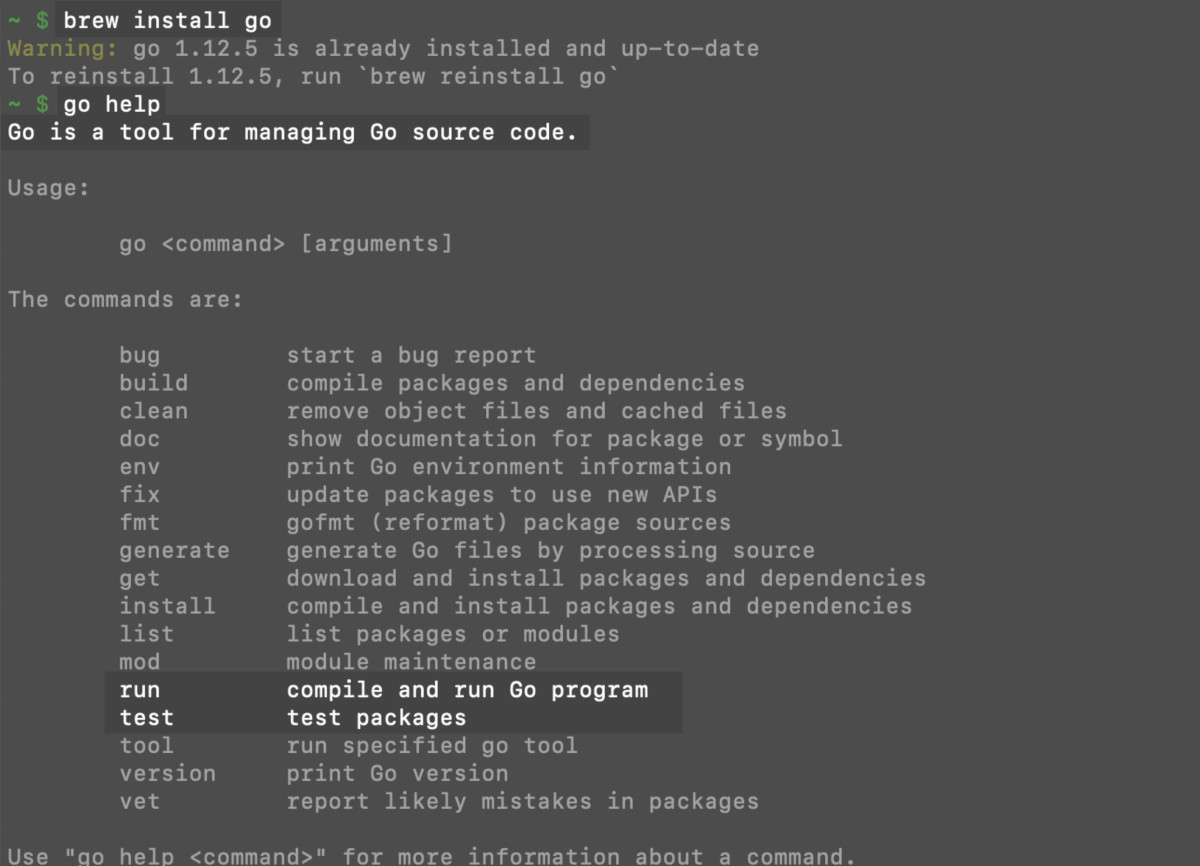

- #Golang install mac how to
- #Golang install mac full
- #Golang install mac pro
- #Golang install mac code
The plugin is very easy to download on Vscode, in the leftmost vertical navigation bar Extensions.
#Golang install mac how to
Not much to say, let's see how to configure the Go locale on it.

The whole thing is that it has a very powerful community with feature-rich plugins where you can program almost any language. Of course, if your computer is configured against the sky (such as iMac Pro), you can of course ignore it.
#Golang install mac pro
It's really lightweight, anyway, I haven't encountered it in my macbook pro 2013 (8g i7), and if I use goland, it will often get stuck. The reason I love vscode is that it is lightweight, and the second is its versatility.
#Golang install mac full
To simplify the explanation, I direct you to reveal the full index.sh is as follows: export $GOPATH= $HOME/Developer/goĮxport $GOROOT=/usr/ local/opt/go/libexec export PATH= $PATH: $GOPATH/bin: $GOROOT/bin At the same time we can also index.sh set on $PATH. So we set above using $GOPATH the second method, then, in index.sh the Add files on this line can be set GOROOT: export GOROOT=/usr/local/opt/go/libexec. If you install Golang using Homebrew, it $GOROOT will be mapped to /usr/local/opt/go/libexec. For the sake of understanding, we can also set it here. On the Mac we do not need to set up $GOROOT, but on Windows you need.
#Golang install mac code
In fact, it is the location where the Golang source code is stored, which contains some of the library files that come with Golang. The first one is $GOPATH/bin, the second one is $GOROOT/bin. There are usually two folders for storing Golang binaries. This is because there are times when we want to run some Golang terminal binary files directly, if you do not have to store binary Golang folder included in the $PATH inside, the terminal can not find them. When you are done configuring $GOPATH, you have to configure it $PATH. The principle is to do source the command will go to the introduction of ~/Developer/index.sh the contents inside. After this, you can modify $HOME/Developer/index.sh to set environment variables, rather than to modify ~/.bash_profile files. bash_profile file by command export GOPATH=$HOME/Developer/go, add this line source $HOME/Developer/index.sh, and then save and exit. At this time, we sudo nano ~/.bash_profile delete the original. For example, if we create a file $HOME/Developer/index.sh, we can export GOPATH=$HOME/Developer/go enter the original file into it. We can create another file to store environment variables. bash_profile password authorization, but also a lot of trouble. If every time by sudo nano ~/.bash_profile modifying environment variables too much trouble, but also by other editors, for example vscode need to modify each. Finally, according to ctrl + x exit nano editor.

After the input is complete, press ctrl + o then press enter to save. $HOME/Developer/go It is my favorite GOPATH folder location, you can set a folder location arbitrarily.

bash_profile add a line in the file: export GOPATH=$HOME/Developer/go Run the command above will open a nano editor in Terminal to edit ~/.bash_profile the file. Variable is set directly to the ~/.bash_profile file, the specific operation is as follows: $ sudo nano ~/.bash_profile We can set environment variables in two ways. The Go language requires that you provide a $GOPATH variable in the system's environment variables, as the name suggests, to give the Go language a folder location to manipulate. Once the installation is complete, you can use the following command to install the Go language: $ brew install goĪfter the installation is complete, you can run the following command to test it: $ go version You can install Homebrew by running the following command: /usr/bin/ruby -e " $(curl -fsSL )"įor more information about Homebrew, you can visit their website: brew.sh/ Because of Homebrew, it's convenient to download anything on a Mac.


 0 kommentar(er)
0 kommentar(er)
